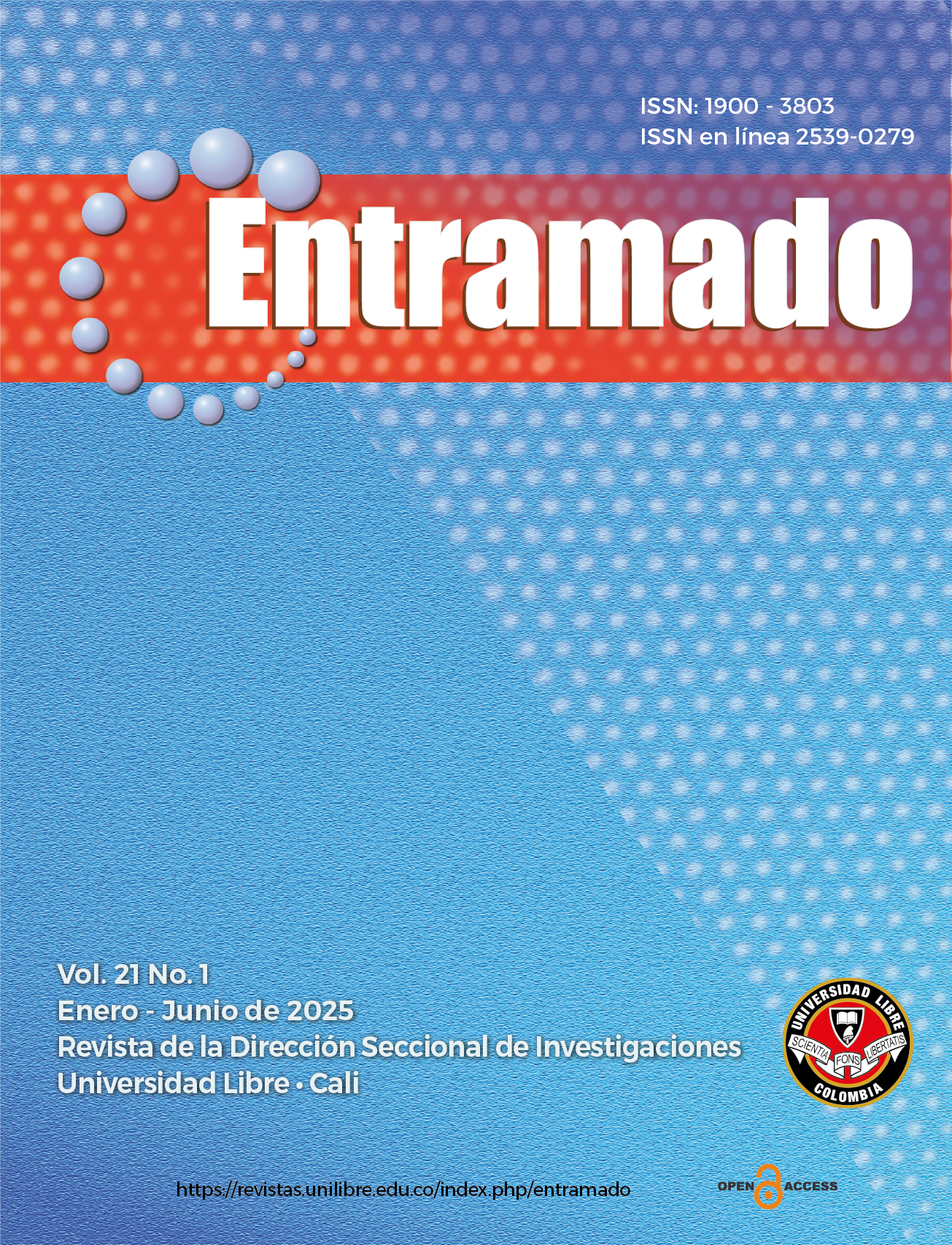Uso del lenguaje incluyente y no sexista: Análisis en una institución pública de salud
DOI:
https://doi.org/10.18041/1900-3803/entramado.1.11197Palabras clave:
Equidad, Diversidad, Inclusión, Instituciones de Salud, Lenguaje, Perspectiva de GéneroResumen
La comunicación incluyente y no sexista tiene por objeto reconocer la diversidad de todas las personas, tener un trato en igualdad y eliminar los estereotipos de género. En las sociedades patriarcales el lenguaje no es incluyente y opera como un elemento que perpetua la desigualdad. El objetivo del estudio es analizar el uso del lenguaje incluyente y no sexista en una entidad pública especializada de salud en Colombia. Para ello se empleó una guía de revisión documental y un instrumento de consulta al personal administrativo y asistencial. Los resultados reflejan que el uso del idioma en los documentos institucionales si bien no se encuentran cargados de sexismo, sí son excluyentes, usando frecuentemente el masculino como genérico. Por su parte, en la comunicación oral se observa que la mayor parte del personal de salud ha percibido por lo menos alguna vez comentarios sexistas y excluyentes dentro de la entidad, en donde se asignan roles y estereotipos a las personas según el sexo. Es imperativo que las instituciones de salud capaciten a su personal en el uso de lenguaje incluyente, promoviendo términos neutros y respetando la identidad de género de cada persona.
Descargas
Referencias
1. BESSONE, Cristian. Mujeres: Imágenes, Publicidades y Campañas de Salud. En: Hermeneutic. 2011. no. 10. https://publicaciones.unpa.edu.ar/index.php/1/article/view/53
2. COMISIÓN NACIONAL DE DERECHOS HUMANOS CNDH. Guía de lenguaje incluyente y no sexista en la CNDH. Ciudad de México, 2016. 32 p. https://www.cndh.org.mx/index.php/documento/fue-presentada-la-guia-para-el-uso-de-unlenguaje-incluyente-y-no-sexista-en-la-cndh-para
3. CONSEJO NACIONAL DE LA CULTURA Y LAS ARTES CNCA. Guía de lenguaje inclusivo de género. Gobierno de Chile. 2016. 12 p. https://www.etsex.cl/wp-content/uploads/2021/05/Chile.-CNCA.-2016.-Guia-de-lenguajeinclusivo-de-genero.pdf
4. ESPINOSA, Sara; LEIVA, María; Hermosín, María; GUERRERO, Laura. ¿Dónde están las mujeres? El impacto del lenguaje sexista en los folletos de Grado de la Universidad de Sevilla. Reflexiones desde la investigación para avanzar en igualdad: VII Congreso Universitario Internacional Investigación y Género. Sevilla: SIEMUS. Seminario Interdisciplinar de Estudios de las Mujeres de la Universidad de Sevilla. 2018. p. 170-185. ISBN: 978-84-948975-3-5
5. FERNÁNDEZ, Sara. La violencia de género en las practicas institucionales de la salud: Afectaciones del derecho a la salud y a las condiciones de trabajo en salud. En: Gerencia y Políticas de Salud. 2007. vol 6, no. 12, p. 52-76. https://revistas.javeriana.edu.co/index.php/gerepolsal/article/view/2699
6. FORO ECONÓMICO MUNDIAL FEM. Global gender gap report 2022. 2022. 374 p. ISBN-13: 978-2-940631-36-0. http://reports.weforum.org/globalgender-gap-report-2022.
7. GUICHARD, Claudia. Manual de comunicación no sexista. Hacia un lenguaje incluyente. Instituto Nacional de las Mujeres. México: Instituto Nacional de las Mujeres. 2015. ISBN: 978-607-7825-53-1
8. HERNÁNDEZ-SAMPIERI, Roberto; FERNANDEZ-COLLADO, Carlos; BAPTISTA-LUCIO, Pilar. Metodología de la Investigación. Sexta Edición. México: McGRAW-HILL Education. 2014. ISBN: 978-1-4562-2396-0
9. HUESCA, María; ORTEGA, Yesika; VELASCO, Nayeli. El lenguaje incluyente: hacia una cultura de los derechos humanos. En: Revista Ciencia Administrativa. 2018. Vol. 13, p 2-10. https://www.uv.mx/iiesca/files/2019/04/Vol13-2018-Especial_2.pdf
10. LANE, Nikala; PIERCY, Nigel; The ethics of discrimination: Organizational mindsets and female employment disadvantage. En: Journal of Business Ethics. 2003. vol 44, p. 313-325. https://doi.org/10.1023/A:1023644602447
11. NEWMAN, Costance; DE VRIES, Daniel; KANAKUZE, Jeanne; NGENDAHIMANA, Gerard. Workplace violence and gender discrimination in Rwanda's health workforce: Increasing safety and gender equality. En: Human Resources for Health. 2011. Vol. 19, no. 9. https://pubmed.ncbi.nlm.nih.gov/21767411/
12. ONU MUJERES. Profundicemos en términos: Guía de terminología y uso del lenguaje no sexista para periodistas, comunicadoras y comunicadores. 2016. 117 p. http://onu.org.gt/wp-content/uploads/2017/10/Guia-lenguaje-no-sexista_onumujeres.pdf
13. ORGANIZACIÓN DE LOS ESTADOS AMERICANOS OEA. Guía de Comunicación inclusiva para la Secretaría General de la OEA. 2021. 63 p. ISBN: 978-0-8270-7163-6. http://www.oas.org/es/cim/docs/GuiaComunicacionInclusivaOEA-ES.pdf
14. ORGANIZACIÓN MUNDIAL DE LA SALUD Y ORGANIZACIÓN INTERNACIONAL DEL TRABAJO. La brecha salarial de género en el sector de la salud y asistencial. Un análisis mundial en tiempos de Covid-19. 2022. 161 p. https://www.who.int/es/publications/i/item/9789240052895
15. PANISELLO, María; PASTOR, Inma; MATEU, María; PANISELLO, Anna. Análisis de la perspectiva de género en los Planes Directores del Departamento de Salud de la Generalitat de Catalunya. En: Feminismos. 2011. vol. 18, p. 135-154. https://rua.ua.es/dspace/bitstream/10045/25497/1/Feminismos_18_07.pdf
16. PANTOJA, Valentina; GONZÁLEZ, Vivian; VIVEROS, Gisela; CATALÁN, Manuel; GONZÁLEZ, Felipe; FRANZ, Nicole; SOTO-SALAZAR, Carolina; VALENZUELA, Valentina; JADUE, Gabriela; VALENCIA, Penélope; HARDEN, Natalia; CRISPI, Francisca. Análisis de contenido de los protocolos de acoso sexual de los 29 Servicios de Salud en Chile. En: Revista Chilena De Salud Pública. 2022. Vol. 26, no. 1, p. 8–21. https://doi.org/10.5354/0719-5281.2022.69147
17. PESCE, Agustina., y ETCHEZAHAR, Edgardo. Actitudes y uso del lenguaje inclusivo según el género y la edad. Búsqueda. 2019. vol. 6 no. 23, e472. https://doi.org/10.21892/01239813.472
18. PROEQUIDAD - COOPERACIÓN TÉCNICA ALEMANA. Género y cambio en la cultura organizacional: herramientas para crear una organización sensible al género. Santa Fe de Bogotá, Colombia: PROEQUIDAD/GTZ. 2000. 168 p.
19. REYES, Mónica. Experiencia durante la formación médica de las mujeres médicas residentes en la universidad nacional de Colombia. Perspectiva de género. Tesis de especialización médica, Universidad Nacional de Colombia. Repositorio Institucional UNAL. 2012. https://repositorio.unal.edu.co/handle/unal/9499
20. SECRETARÍA DE LA FUNCIÓN PÚBLICA. Prontuario para el uso de lenguaje incluyente y no sexista en la Función Pública. Dirección General de Igualdad de Género. México. 2020. 16 p.
21. STETIE, Noelia, y DESMERY, Laila. Lenguaje inclusivo de género: un instrumento para el análisis de representaciones, percepciones y usos. Lengua y Habla. 2024. Vol. 28 no. 1, p. 1–368. https://ri.conicet.gov.ar/handle/11336/247758
22. UGALDE, María. El lenguaje: caracterización de sus formas fundamentales. En: Letras. 1989. vol. 20-21, p. 15-34.
23. UNIVERSIDAD COMPLUTENSE DE MADRID. Guía de comunicación y trato inclusivo. Madrid: Ediciones Complutense. 2021. 142 p.
24. VERDUGO-CASTRO, Sonia; RUEDAS-CALETRIO, Jesús; SÁNCHEZ-GÓMEZ, María. Percepción de los estudiantes, según la rama de conocimiento, sobre la importancia del lenguaje inclusivo en diferentes ámbitos universitarios. La educación en Red. Realidades diversas, horizontes comunes: XVII Congreso Nacional y IX Iberoamericano de Pedagogía. Santiago de Compostela 7-9 de julio de 2021. https://inico.usal.es/publicaciones/percepcion-de-los-estudiantes-segun-la-rama-deconocimiento-sobre-la-importancia-del-lenguaje-inclusivo-en-diferentes-ambitos-universitarios/
Publicado
Número
Sección
Licencia
Derechos de autor 2024 Entramado

Esta obra está bajo una licencia internacional Creative Commons Atribución-NoComercial-CompartirIgual 4.0.


